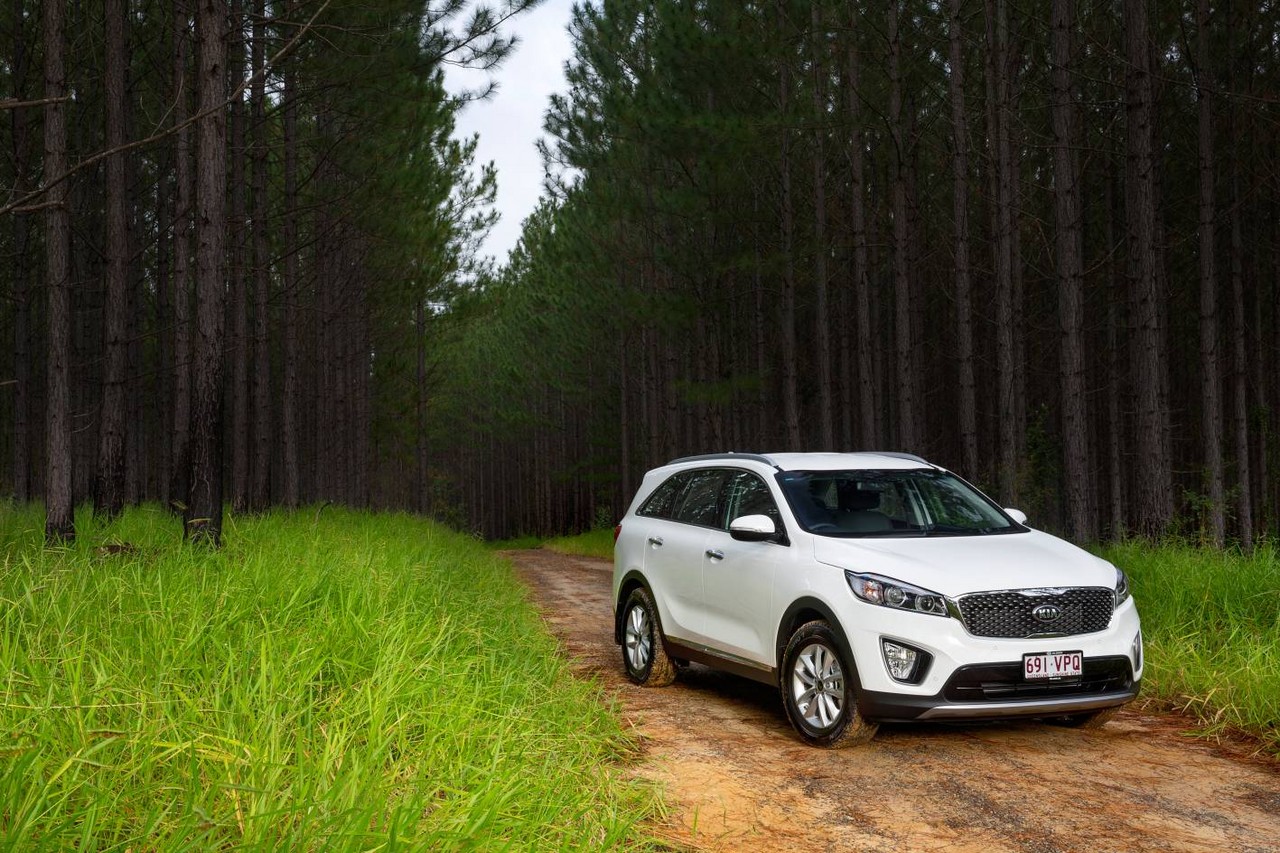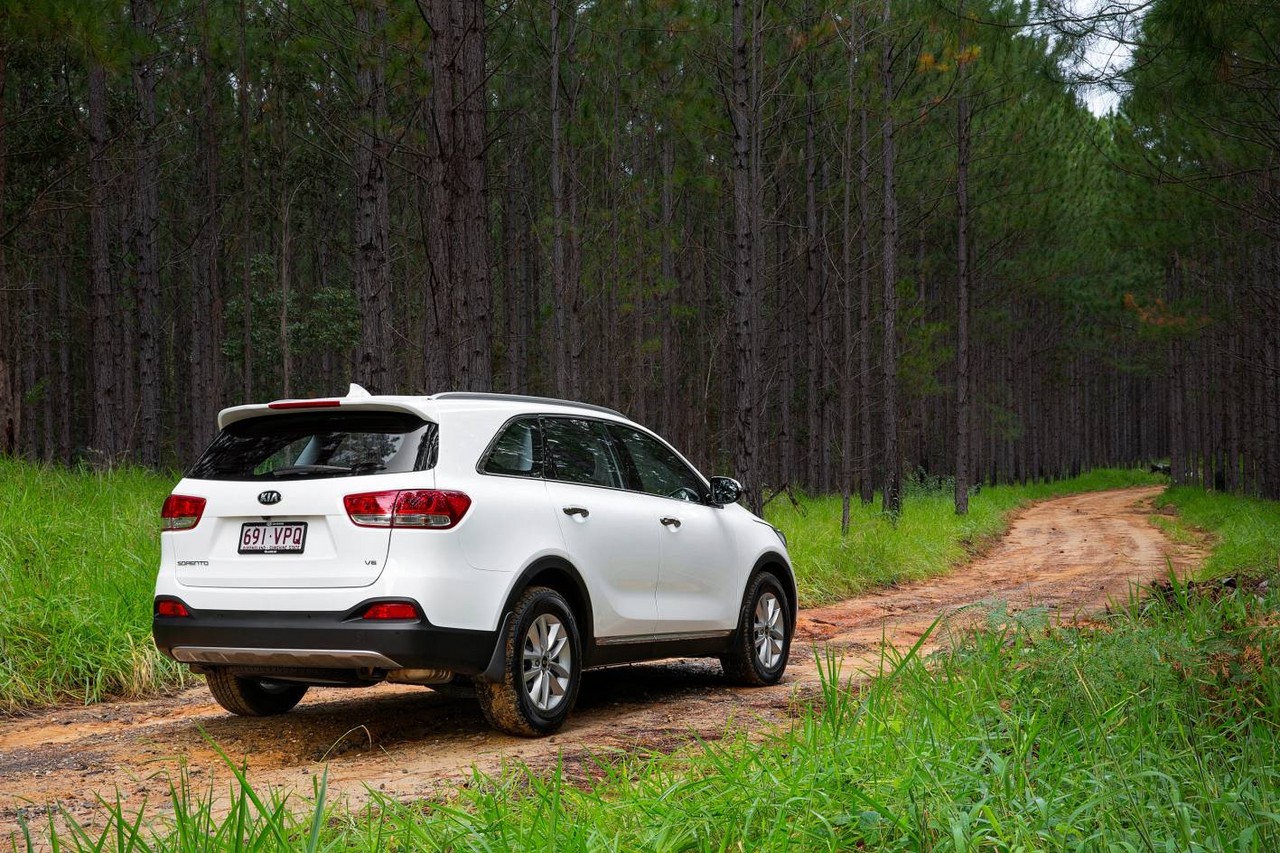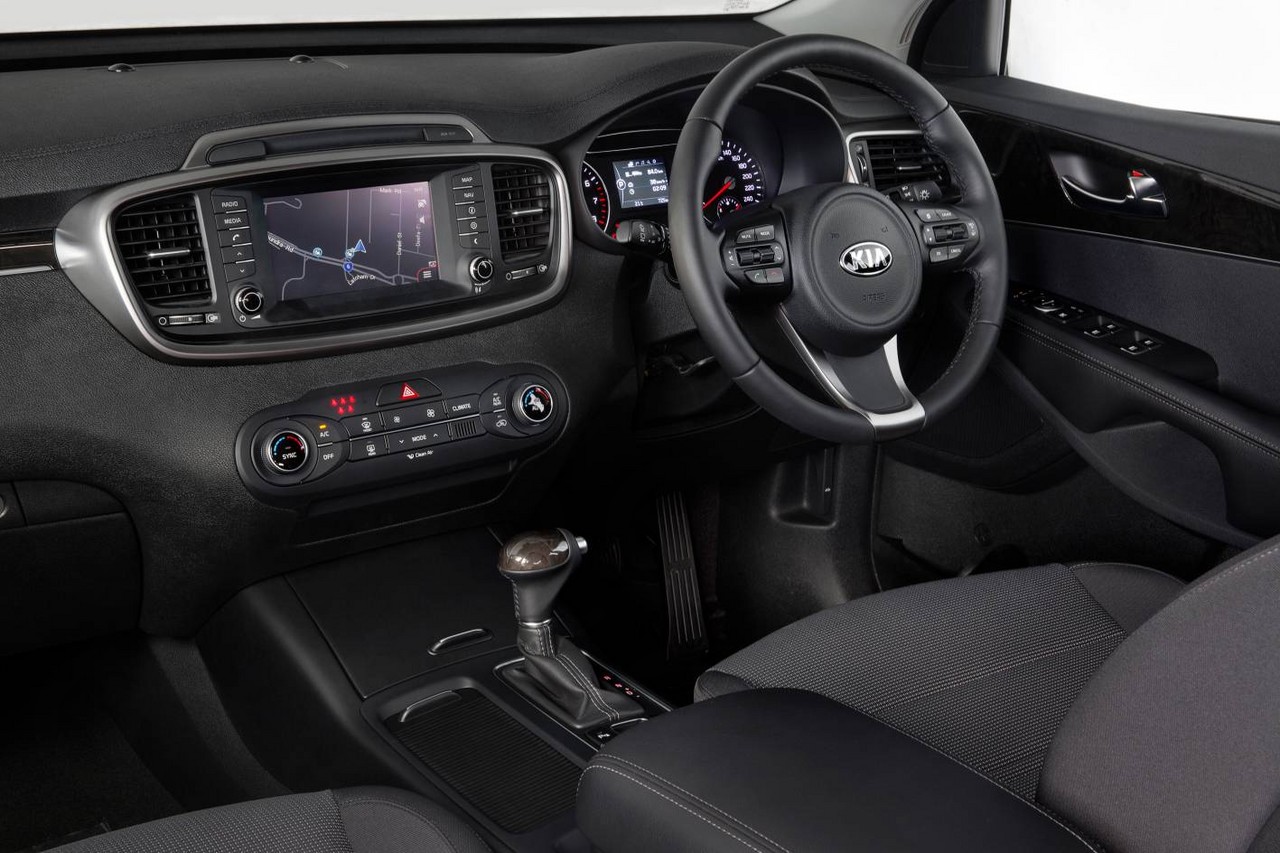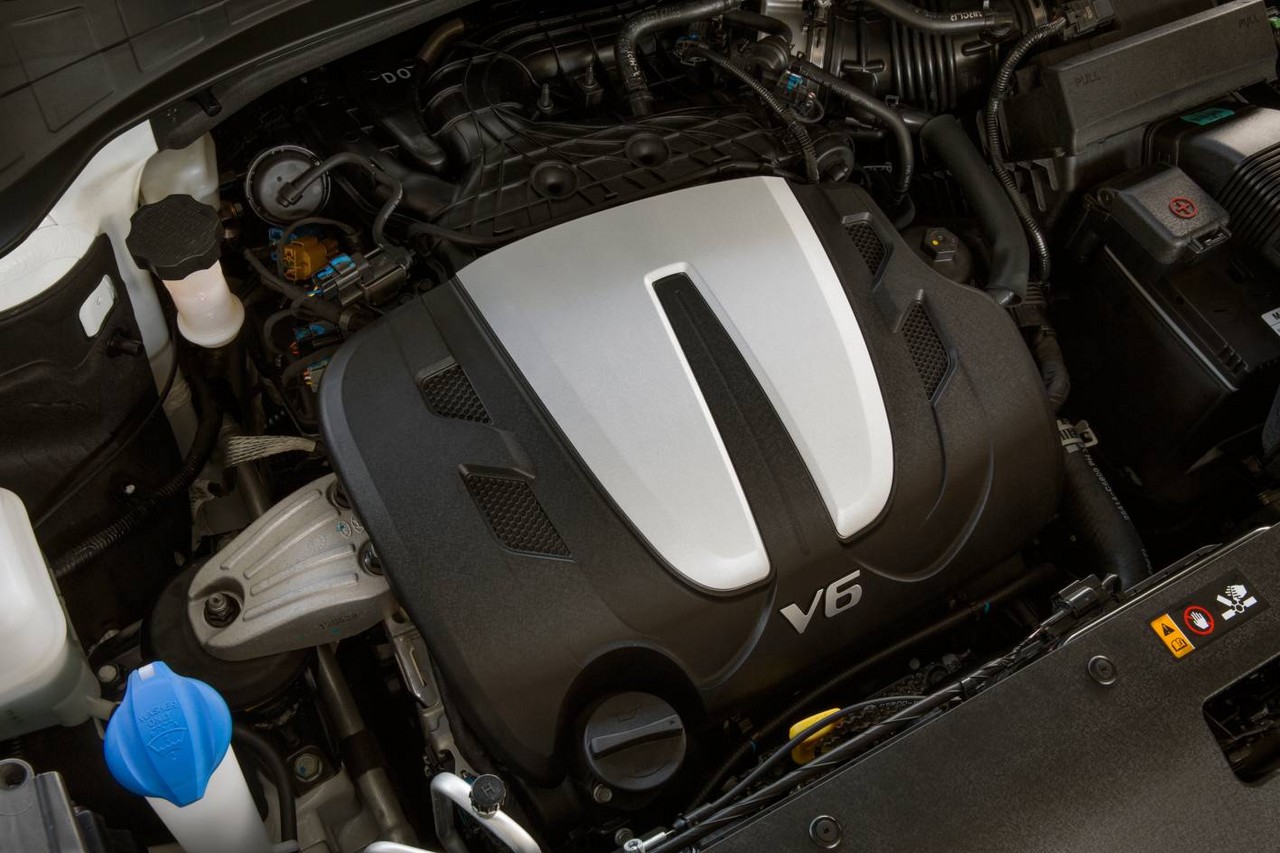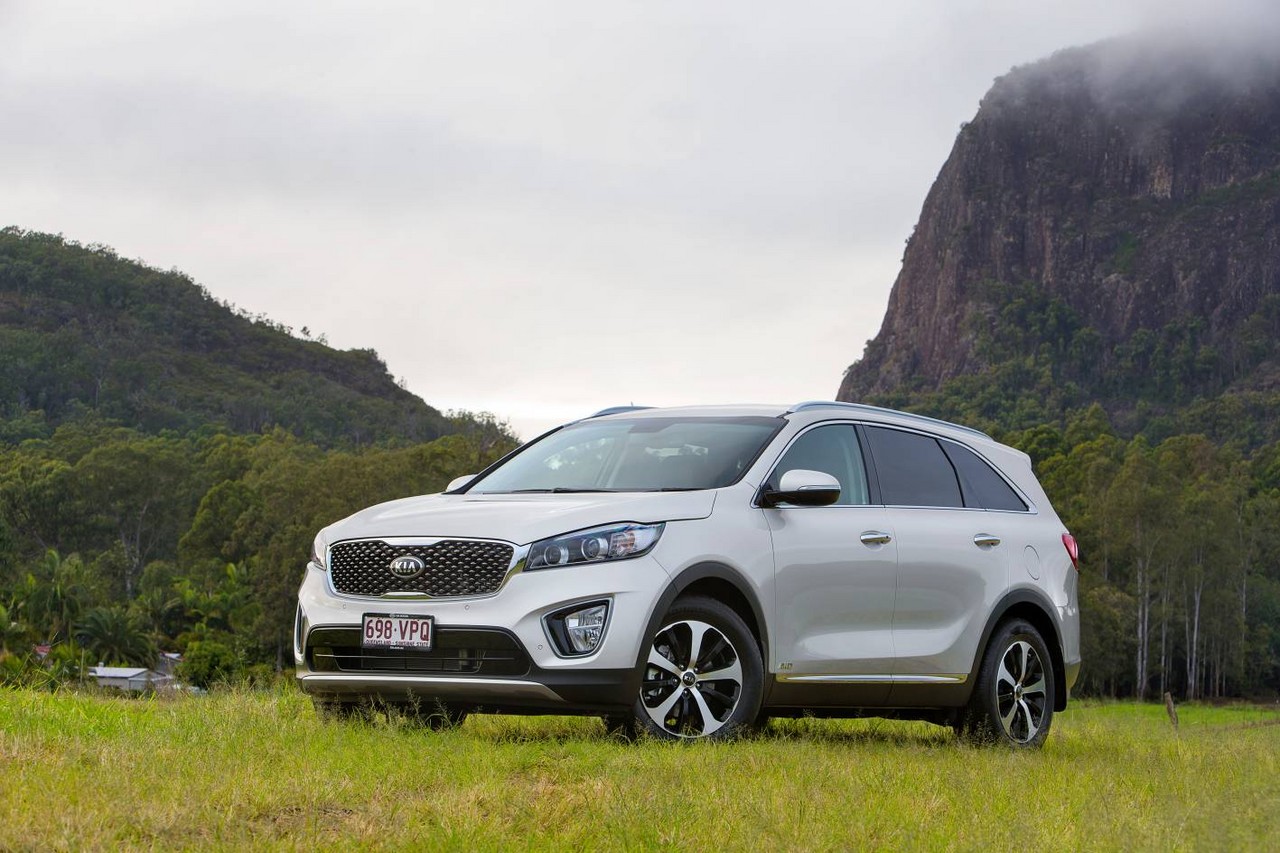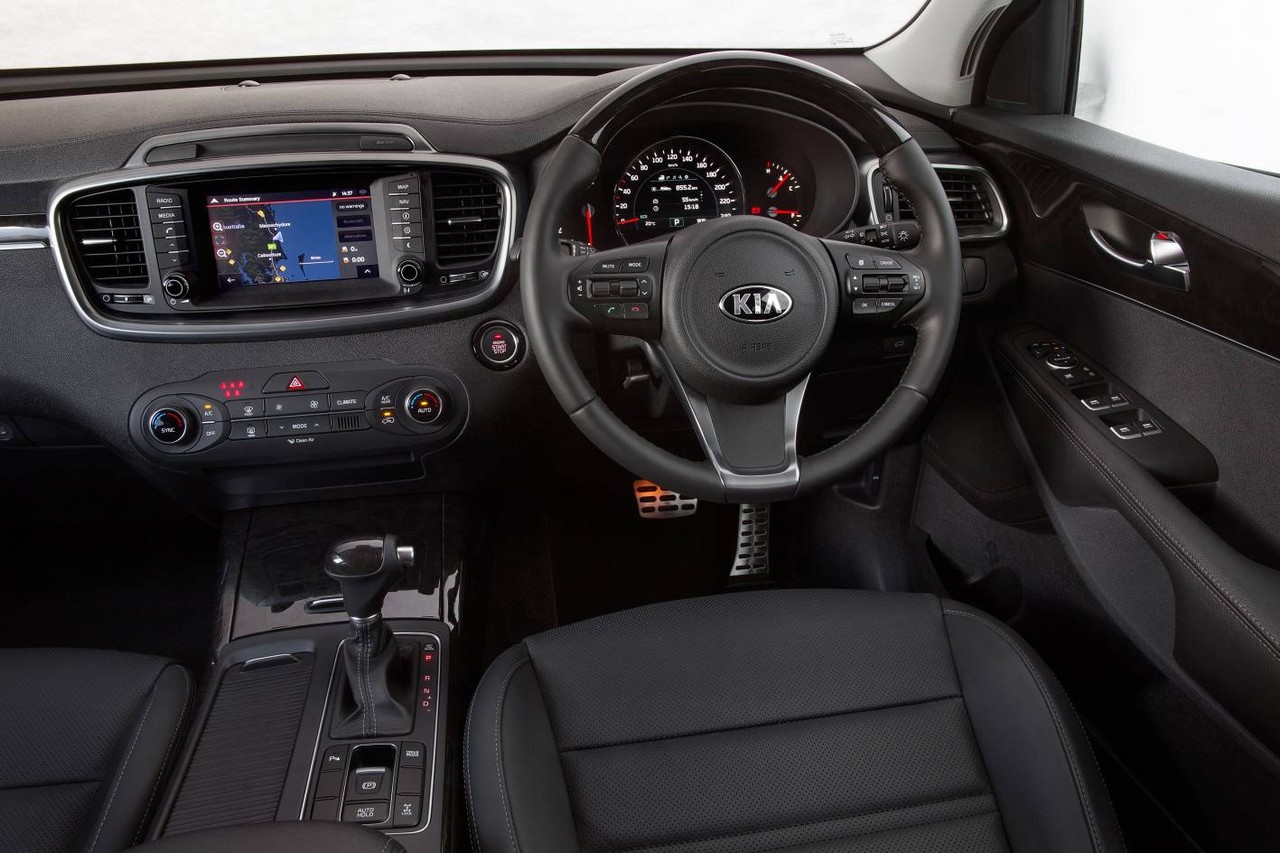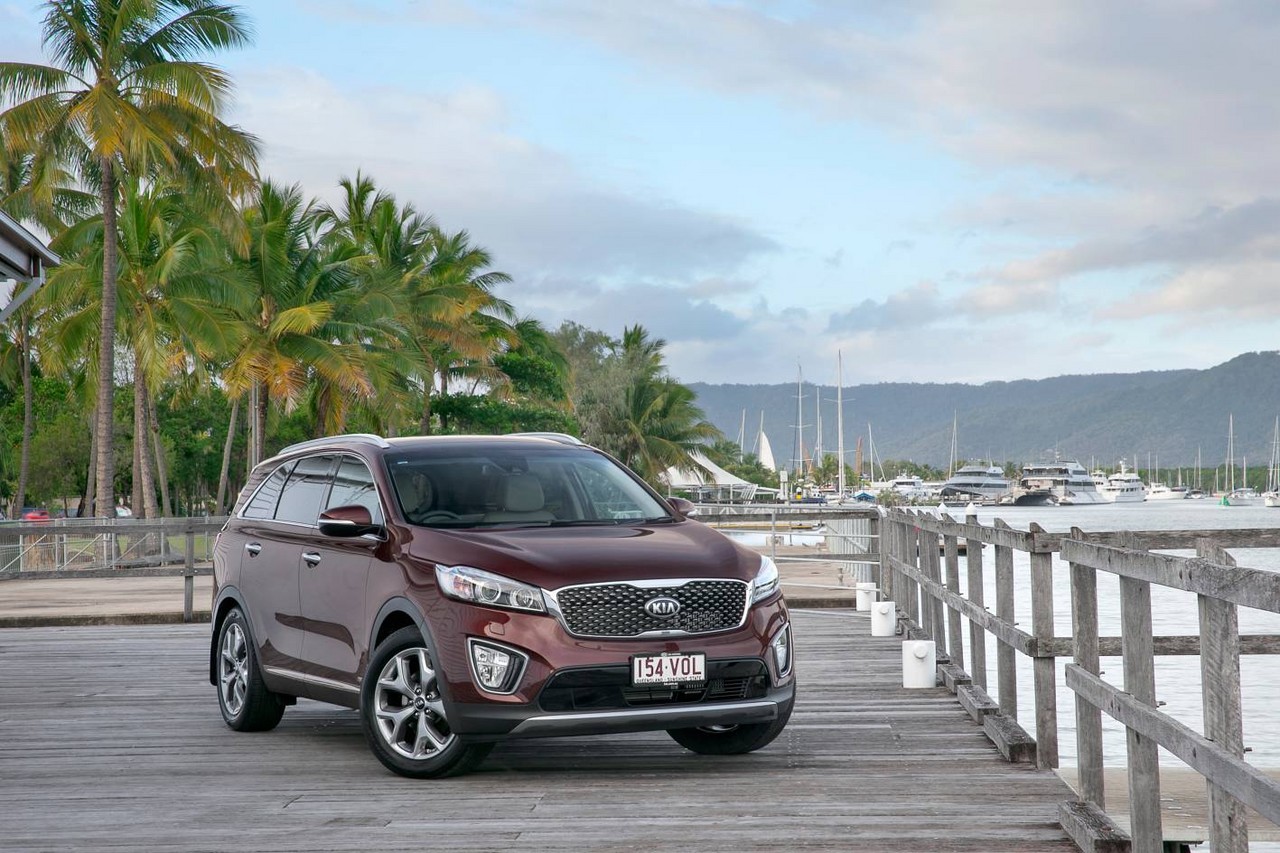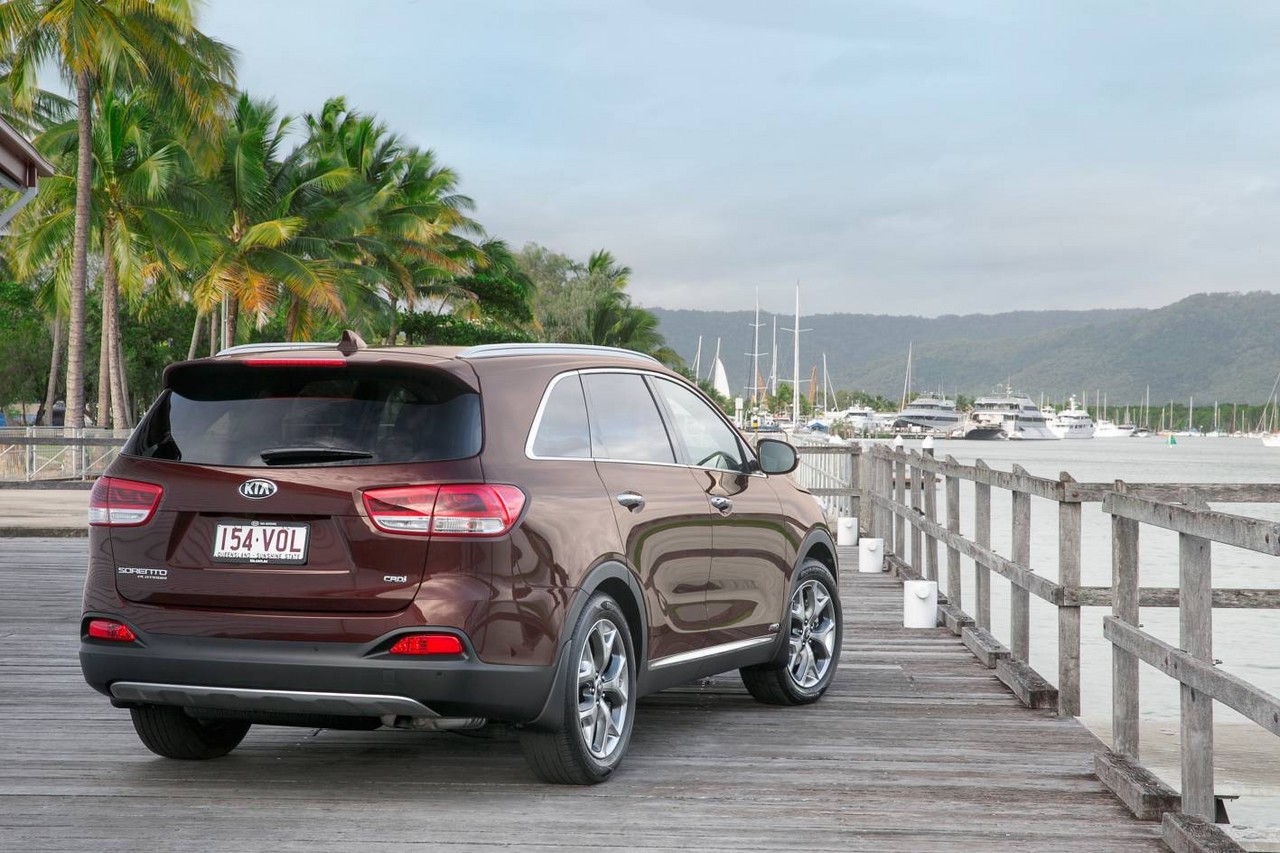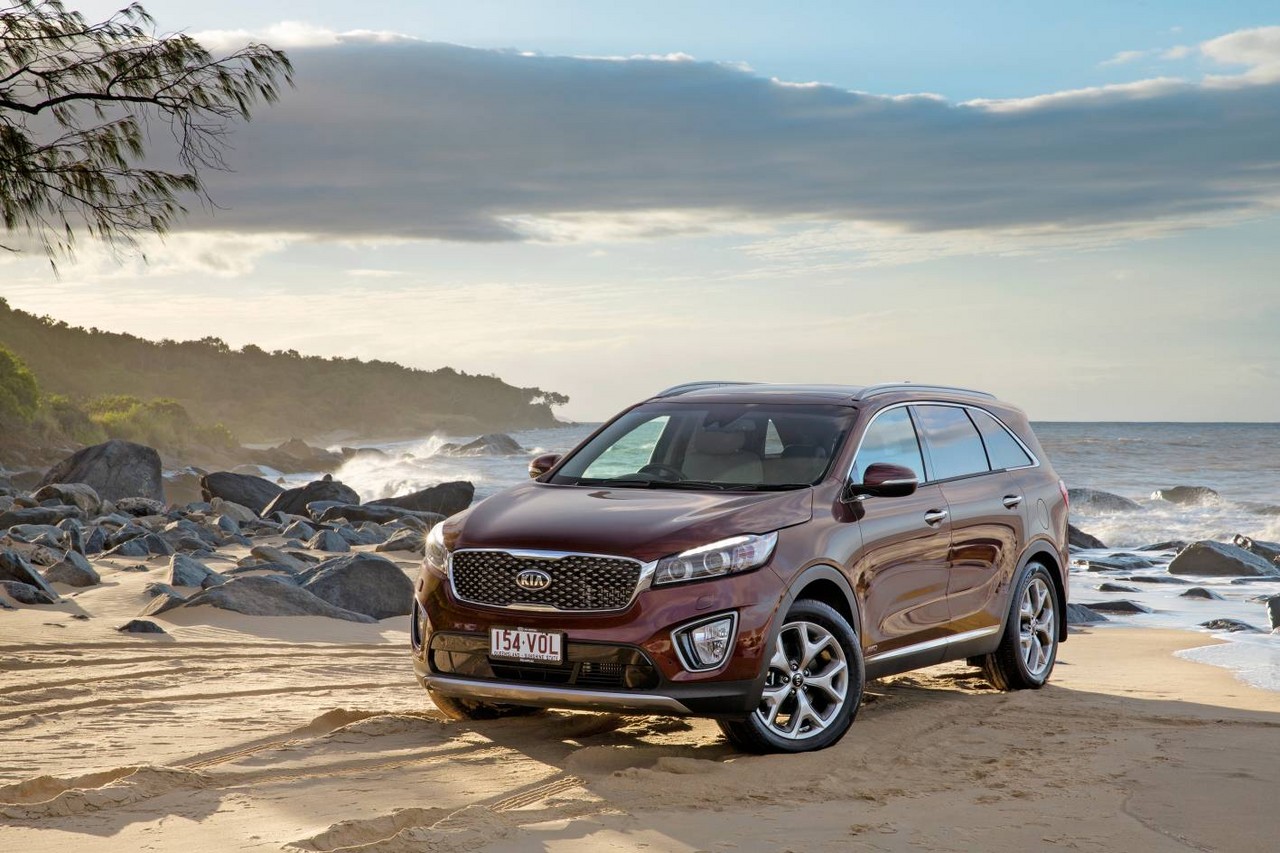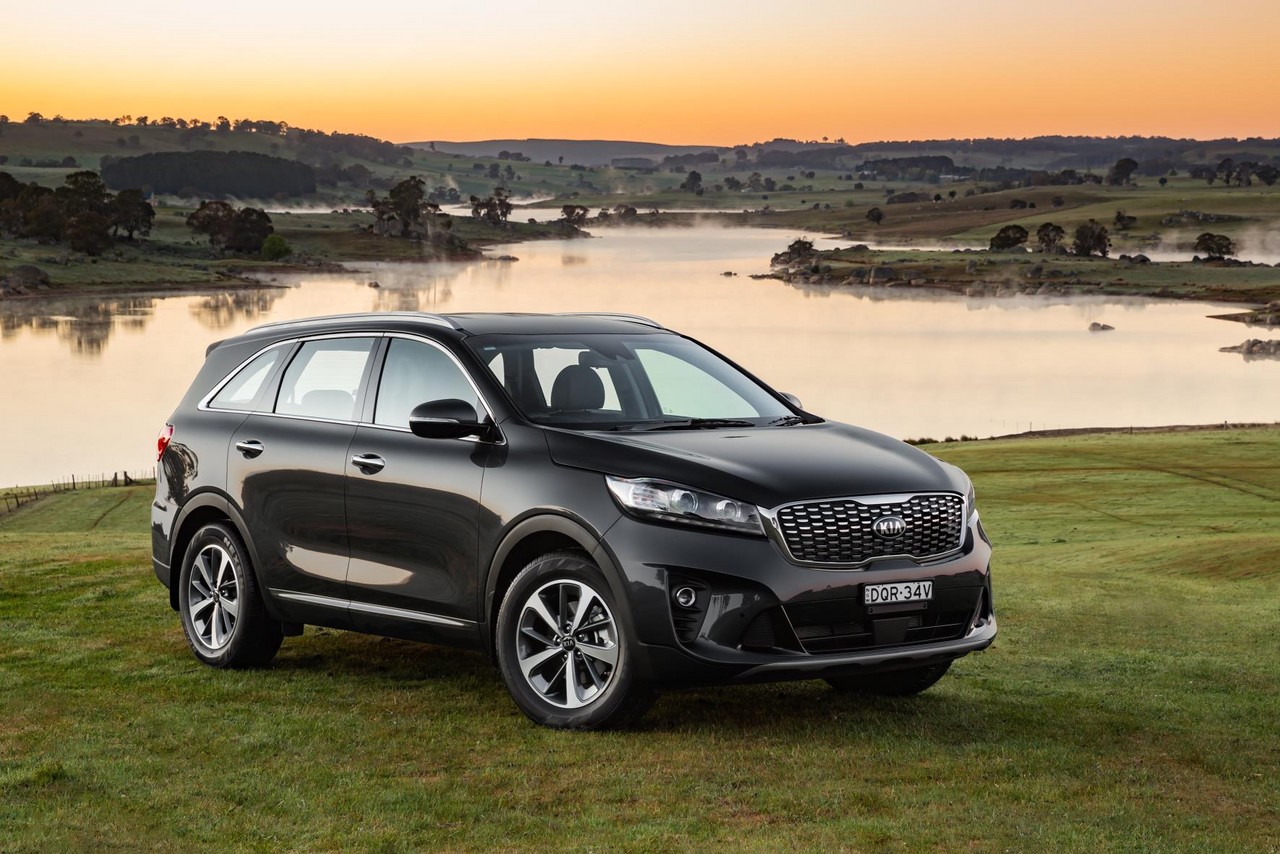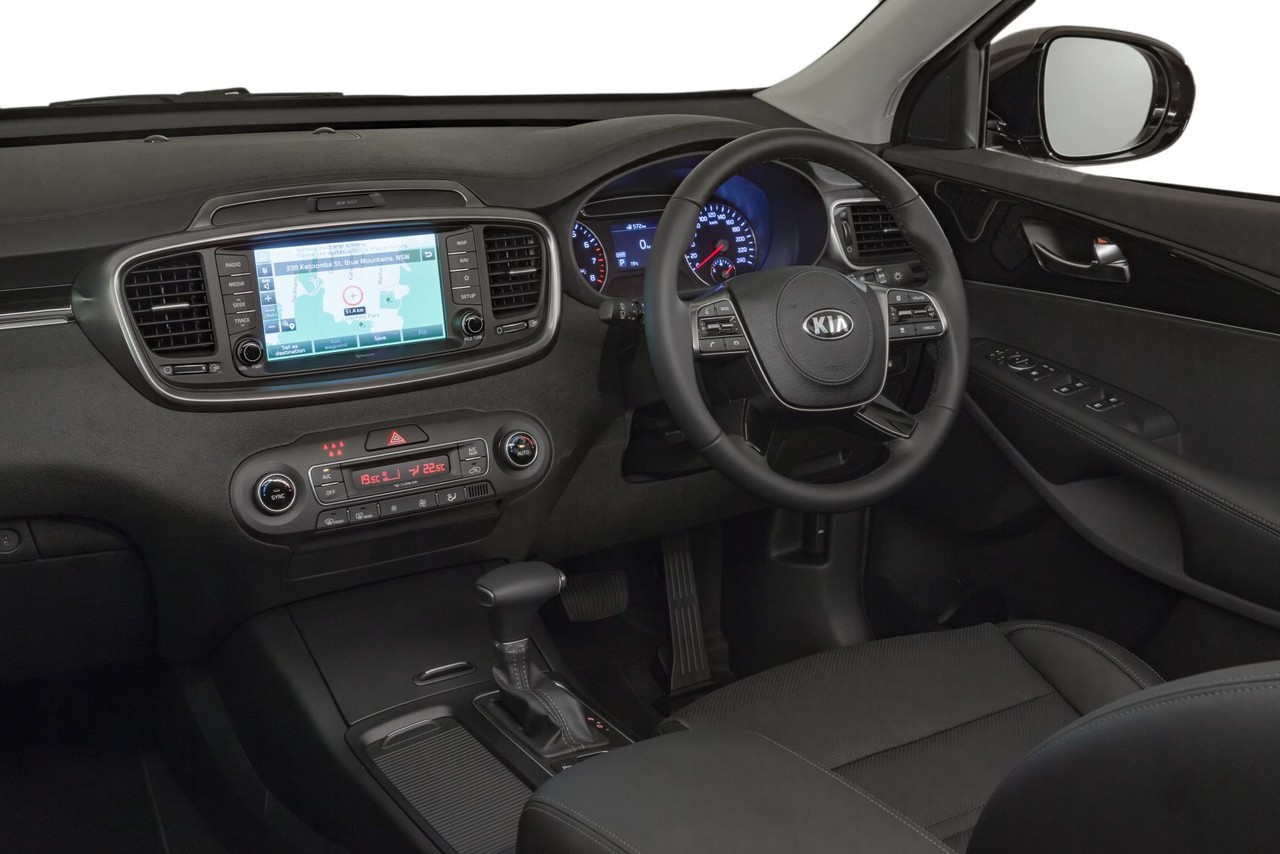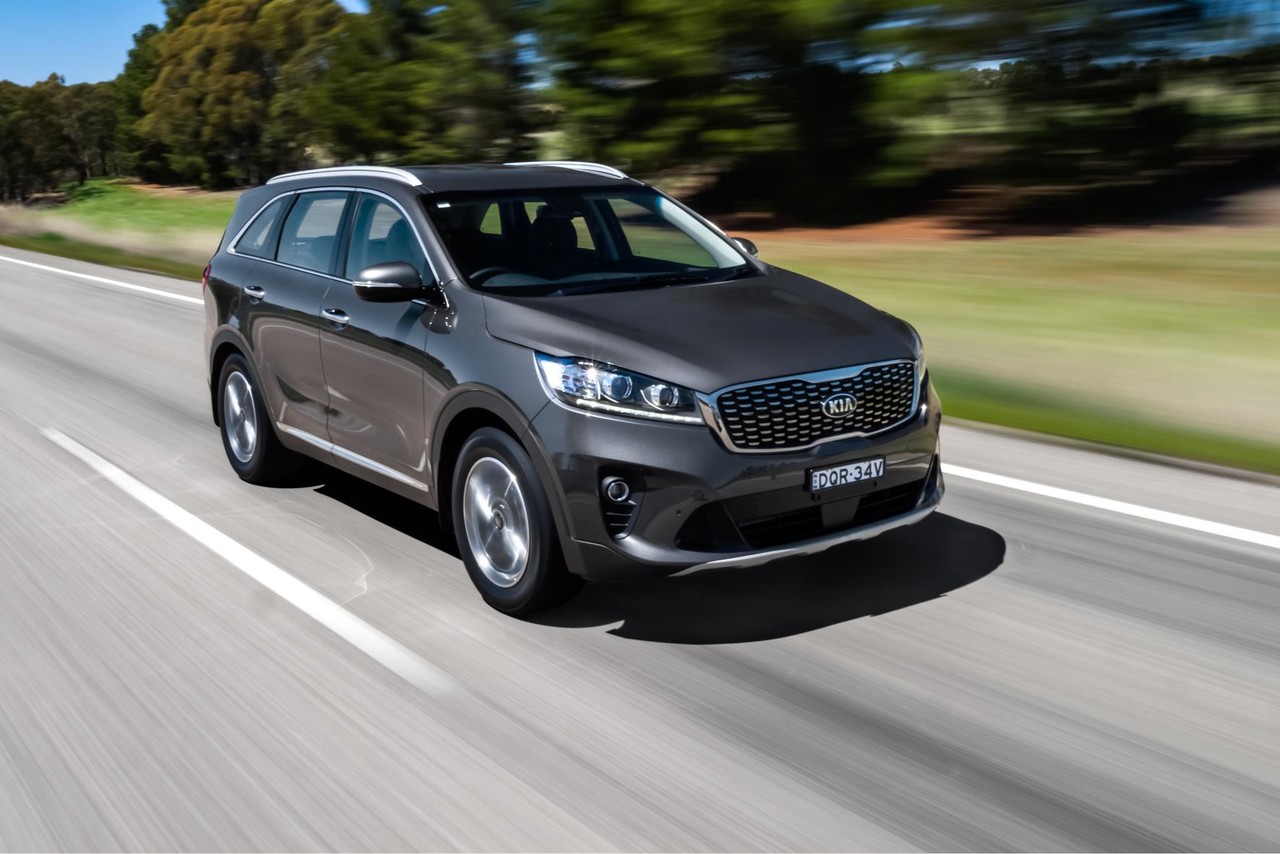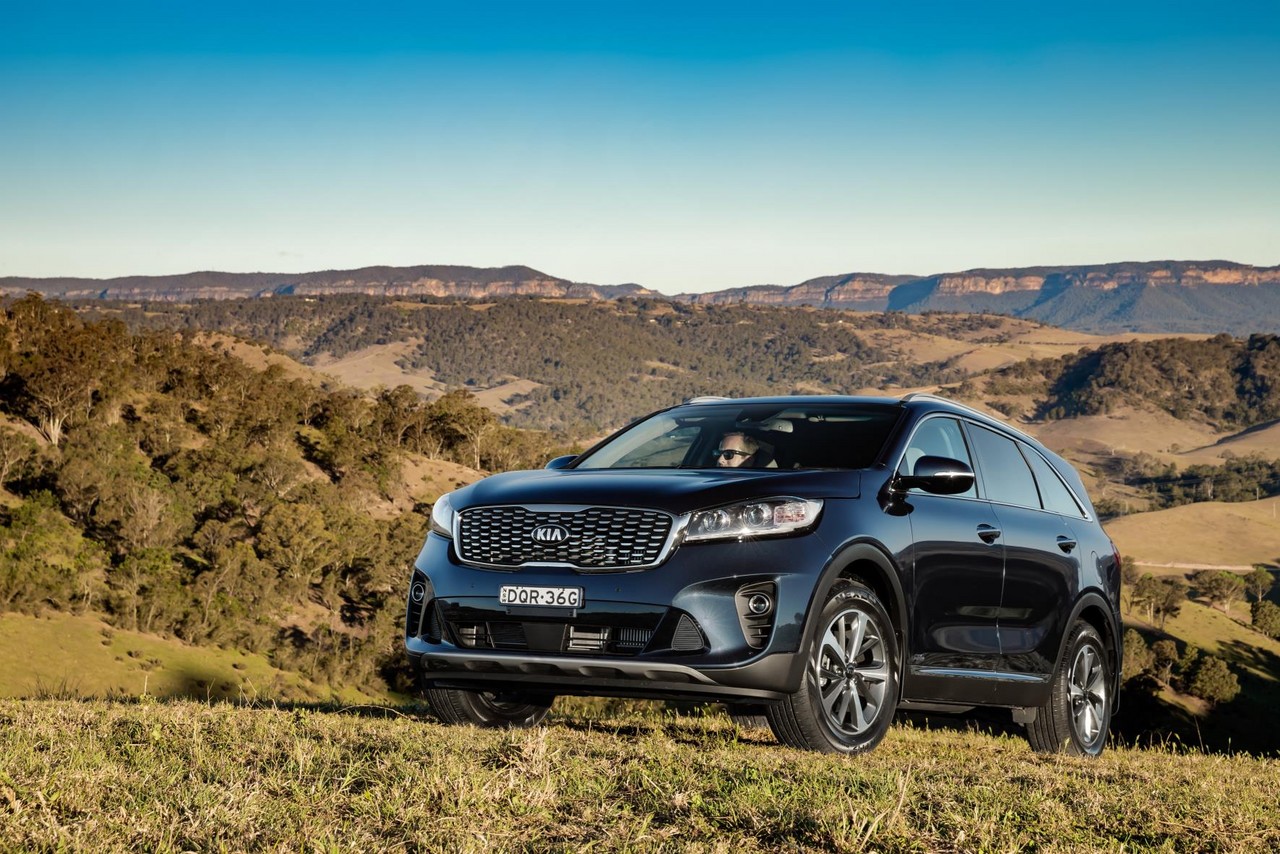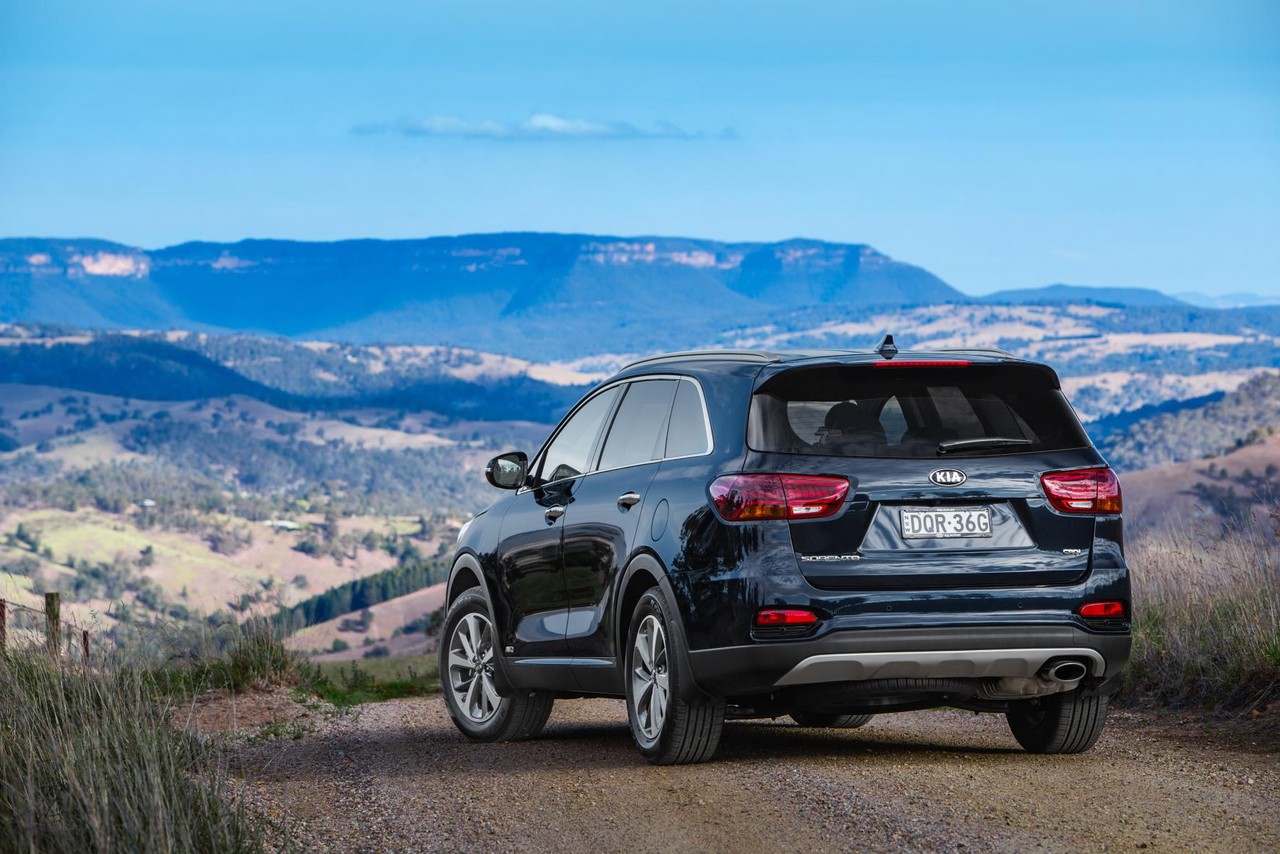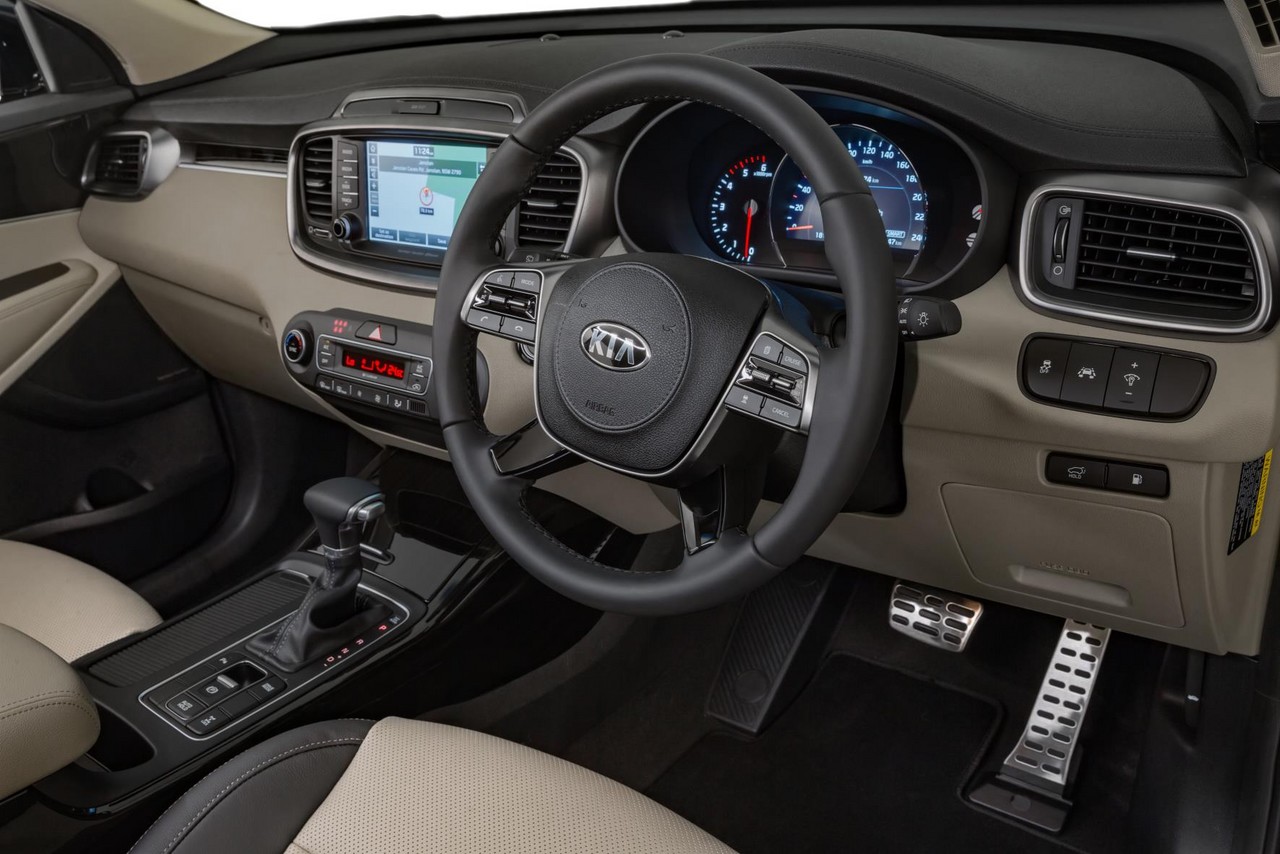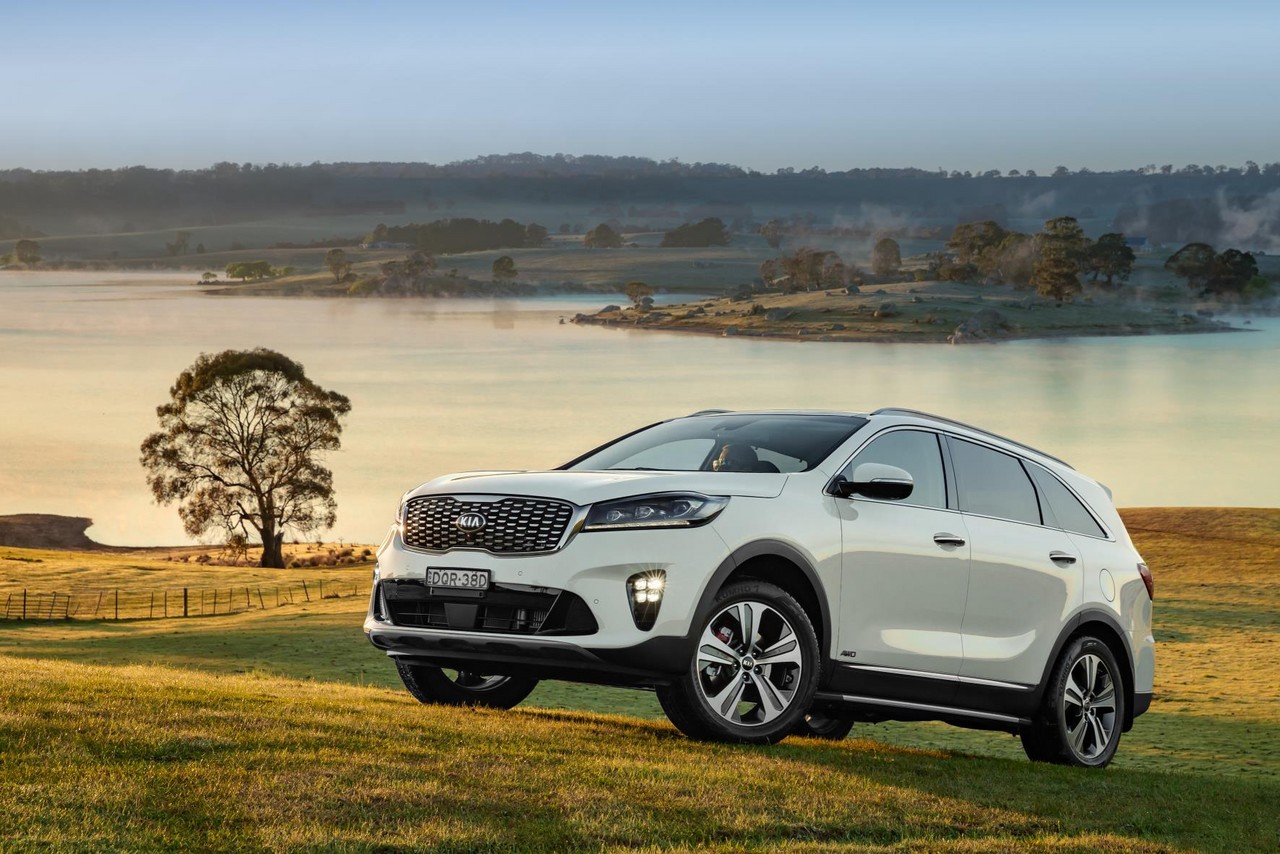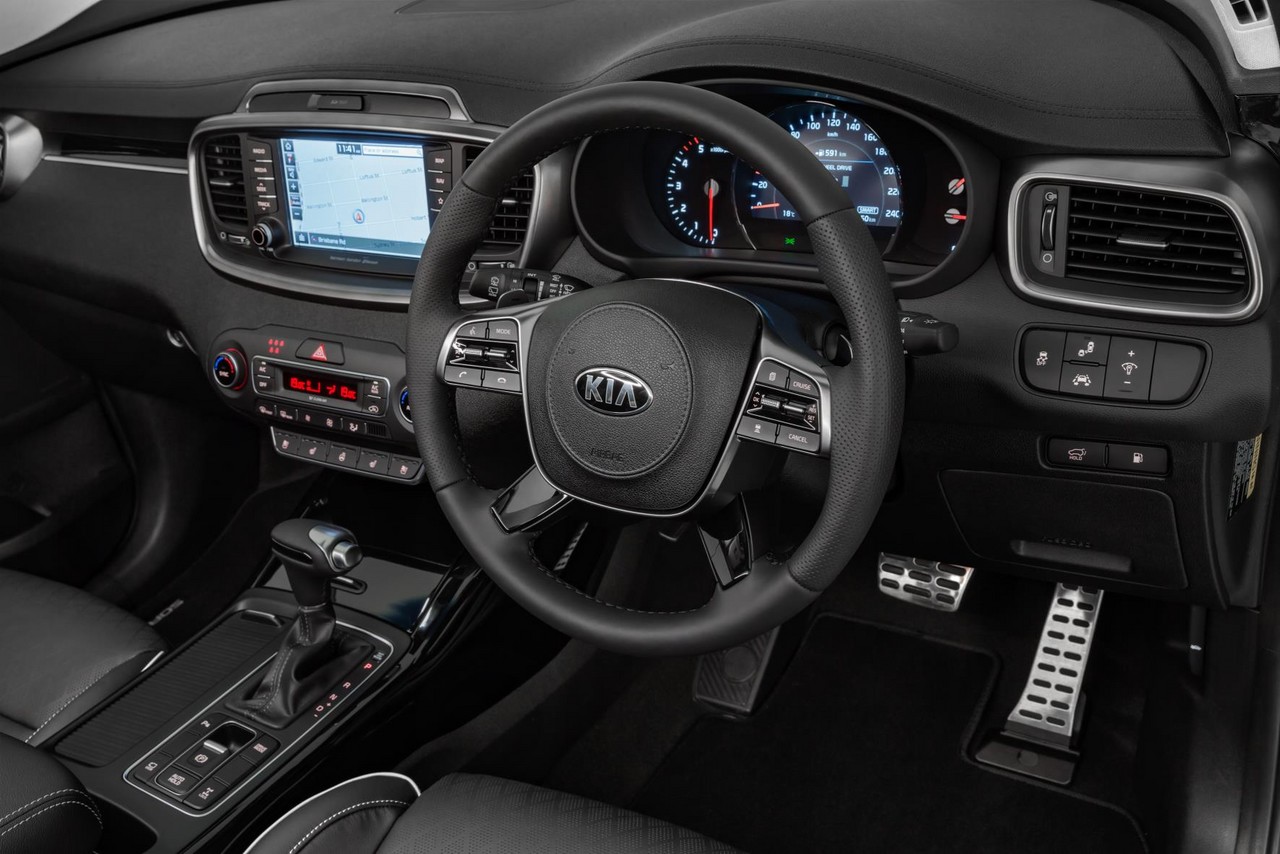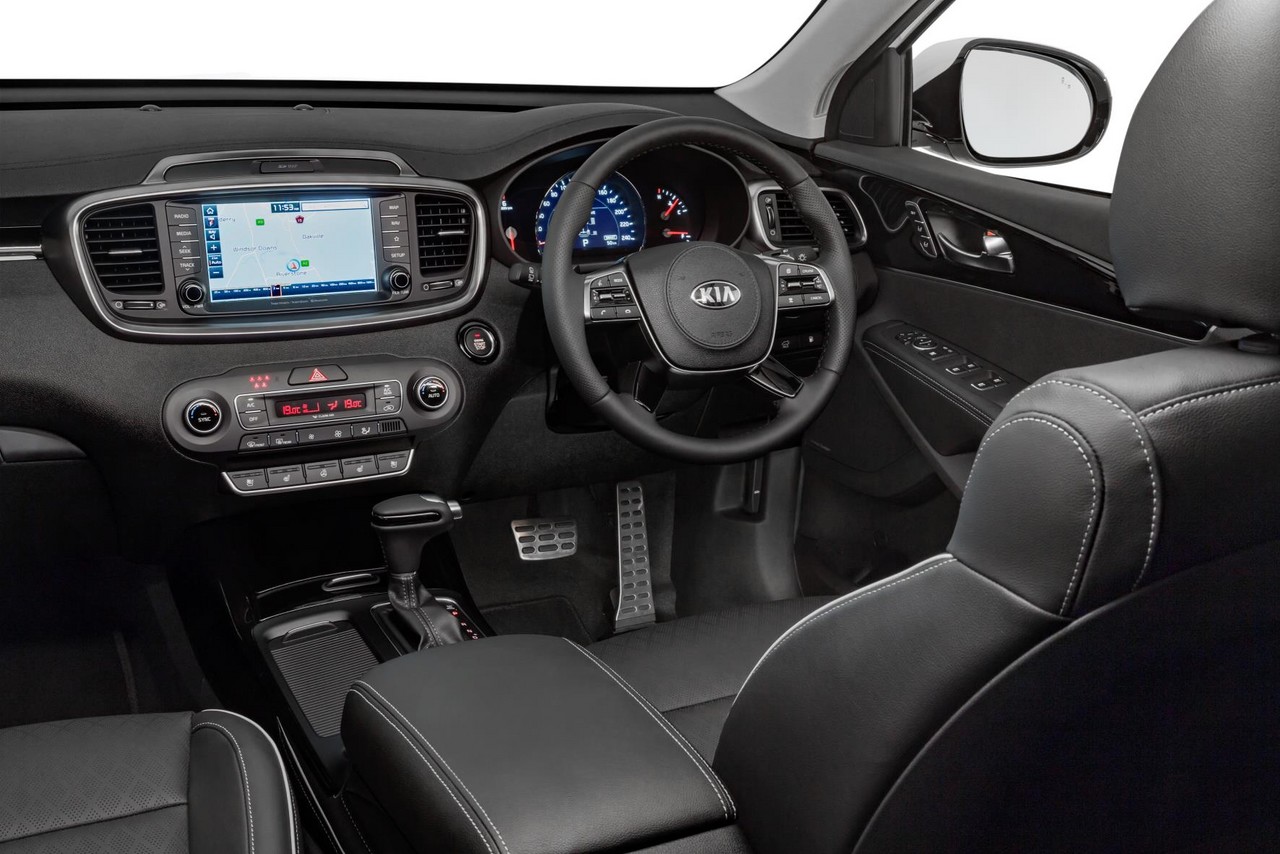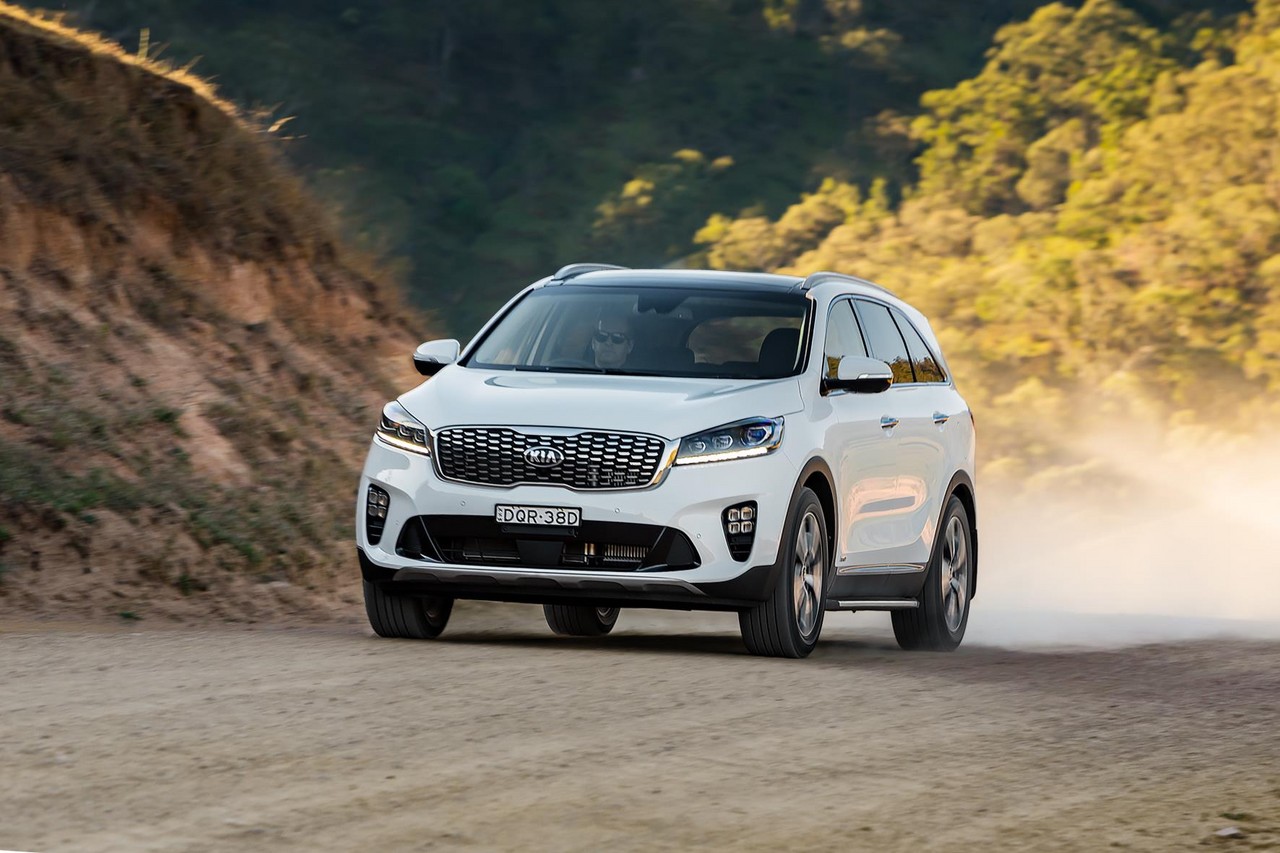
- Refined turbo-diesel engine
- Comfortable ride
- Quiet, well-insulated cabin
- High standard of interior fit and finish
- Seven-year warranty
- For Sorentos with turbo-diesel engines, suspension lacks body control
- Automatic transmission hardly intuitive and sequential gearshifts often ignored
- Overly-assisted steering lacks feel
- Reflective touchscreen
Review: Kia UM.I Sorento (2015-17)
Overview
Released in Australia in June 2015, the Kia UM Series I (UM.I) Sorento was a seven-seat SUV. Manufactured in South Korea, the UM Sorento was available with two powertrains:
- Front wheel drive and with 3.3-litre V6 petrol engines; or,
- All-wheel drive and with 2.2-litre four-cylinder turbo-diesel engines.
For both engines, a six-speed automatic transmission was fitted as standard.
The Kia UM Sorento range initially consisted of Si, SLi and Platinum variants. In October 2016, however, range-topping GT-Line variants were introduced.
D4HB diesel and G6DB petrol engines
Of the engines,
- the 2.2-litre D4HB ‘R’ diesel engine had an aluminium engine block and cylinder head, common-rail direct injection with piezo injectors (operating at 1800 bar), a variable geometry turbocharger, double overhead camshafts, four valves per cylinder and a compression ratio of 16.0:1; and,
- the 3.3-litre G6DF ‘Lambda’ V6 petrol engine had an aluminium block and cylinder heads, multi-point injection, double overhead camshafts, four valves per cylinder, dual continuously variable intake valve timing (D-CVVT), a variable intake system (VIS) and a compression ratio of 10.6:1.
For both petrol and diesel models, the driver could select from Normal, Eco and Sport drive modes which varied gearshift behaviour and steering assistance.
Over the combined ADR 81/02 test cycle, fuel consumption for the petrol and diesel engines was 9.9 litres per 100 km and 7.8 litres per 100 km, respectively.
| Engine | Variant | Drive | Trans. | Peak power | Peak torque |
|---|---|---|---|---|---|
| 3342 cc G6DF petrol V6 | Si, SLi |
FWD | 6sp auto | 199 kW at 6400 rpm | 318 Nm at 5300 rpm |
| 2199 cc D4HB turbo-diesel I4 | Si, SLi, Platinum |
AWD | 6sp auto | 147 kW at 3800 rpm | 441 Nm at 1750-2750 rpm |
All-wheel drive system
Like the Kia SL Sportage , the UM Sorento models with 2.2-litre turbo-diesel engines had a ‘Dynamax’ all-wheel drive (AWD) system that was manufactured by Magna International . In normal conditions, the engine’s torque was directed to the Sportage’s front wheels. The Dynamax AWD system, however, was pro-active in that it used inputs from sensors to monitor driving conditions and anticipate AWD requirements, rather than responding to a loss of traction (reactive). When a loss of traction was anticipated, the electrohydraulic multi-plate clutch would engage to direct up to 50 per cent of the engine’s torque to the rear axle.
For the Kia UM Sportage, the Dynamax AWD system included a ‘4WD Lock’ mode provided a 50:50 front:rear torque split for low-traction conditions. Furthermore, an Advanced Traction Cornering Control (ATCC) function could:
- transfer torque to the wheels with the most grip; and,
- reduced understeer by braking the inner rear wheel and providing more torque to the outer rear wheel.
Body and dimensions
Compared to the Kia XM Sorento , the UM Sorento was 95 mm longer (at 4780 mm), 5 mm wider (1890 mm), 10 mm lower (1690 mm) and had an 80 mm longer wheelbase (2780 mm); ground clearance was 185 mm. Kerb weight for the petrol and diesel Sorento models was 1875 kg and 1985 kg, respectively.
The UM Sorento’s bodyshell consisted of 52.7 per cent ultra-high tensile steel (UHTS) and, relative to its XM predecessor, achieved a 14 per cent increase in torsional rigidity. For greater refinement, other developments included:
- new soundproofing material for the transmission tunnel;
- a thicker dashboard soundproofing panel (increased from 0.7 mm to 0.9 mm);
- larger engine and transmission mounts; and,
- for diesel models, a new diesel particulate filter (DPF) cover and an acoustic shield integrated into the engine’s timing chain cover.
The Kia UM Sorento had maximum braked towing capacity of 2000 kg.
Suspension
The Kia UM Sorento had MacPherson strut front suspension and independent, multi-link rear suspension. For the UM Sorento, changes include larger shock absorbers mounted vertically behind the axle line for improved body control and larger bushings for the rear subframe. Furthermore, Australian-delivered Sorento models had suspension settings developed specifically for local conditions.
Steering
The Kia UM Sorento had a rack-mounted, electric motor-driven power steering system (Kia’s R-MDPS). The turning circle for the Kia Sorento was 11.1 metres.
Safety equipment
Standard safety equipment for the Kia UM Sorento included dual front airbags, front side airbags, curtain airbags (for the front and second row occupants), ABS, electronic brake force distribution, brake assist, electronic stability control, traction control, active front seat head restraints and front seatbelts with pretensioners and load limiters.
The Sorento Platinum and GT-Line were further equipped with:
- Lane Departure Warning System (LDWS): used a forward-facing camera to detect the car’s position within its lane and alerted the driver if they departed from the lane without indicating;
- Blind Spot Detection (BSD) and Lane Change Assist (LCA): monitored the area up to 70 metres behind the Sorento and provided a visual warning in the door mirror when another car enters the driver’s blind spot;
- Rear Cross Traffic Alert (RCTA): could detect approaching traffic that may cross the vehicle’s intended path when reversing out of a parking space and warn the driver; and,
- Smart Cruise Control (SCC): could maintain a pre-set distance between the Sorento and the vehicle ahead, accelerate back to the pre-set cruising speed when the road ahead was clear and bring the vehicle to rest in congested traffic.
From October 2016, the Kia Sorento Platinum and GT-Line were equipped with Autonomous Emergency Braking (AEB) which used front radar sensors to monitor the distance to objects ahead. If the distance decreased such that there was a risk of collision, a warning tone would sound to alert the driver. If a collision was imminent, the brakes would be applied to reduce vehicle speed and the severity of the impact.
Brakes
The Kia UM Sorento had 320 mm by 28 mm ventilated front brake discs and 305 mm by 11 mm solid rear discs.
Euro NCAP and ANCAP assessments
In Euro NCAP testing , the Kia UM Sorento – fitted with a 2.2-litre turbo-diesel engine – received a five star safety rating which included a 90 per cent adult occupant protection rating and an 83 per cent child occupant protection rating. In the offset crash test, protection of the driver’s head, neck, thighs and feet were rated as good, though chest protection and lower leg protection were rated as adequate (i.e. a slight risk of serious injury. In the side impact and pole tests, occupant protection was rated as good for all areas.
Under ANCAP’s 2015 methodology , this testing resulted in five star adult occupant protection rating with a score of 36.62 out of 37.
Features: Kia Sorento Si
Standard features for the Kia Sorento Si included 17-inch alloy wheels with 235/65 R17 tyres, a six speaker sound system, auxiliary inputs (3.5 mm/USB/iPod), Bluetooth mobile phone connectivity and audio streaming, a seven-inch colour touch screen with satellite navigation and live traffic updates, dual-zone climate control air conditioning, black cloth seats, a six-way manually adjustable driver’s seat, cruise control, front and rear fog lamps, front and rear parking sensors, a rear view camera with dynamic guidelines, automatic headlights, 40:20:40 split and flat folding second row seats, 50:50 split and flat folding third row seats, a leather-wrapped steering wheel and gearshift knob, remote central locking, power windows, power adjustable and heated door mirrors, three 12 volt power outlets, two USB chargers, illuminated vanity mirrors, roof rails, a 3.5-inch LCD monochrome instrument cluster, an alarm and immobiliser.
From October 2016, the Kia Sorento Si and SLi were fitted with LED daytime running lights as standard.
Features: Kia Sorento SLi
Compared to the Sorento Si, the Kia Sorento SLi was further equipped with 18-inch alloy wheels with 235/60 R18 tyres, a ten speaker sound system (including subwoofer) with Infinity external amplifier, leather trim seats, an eight-way power adjustable driver’s seat, proximity key, wood-look steering wheel, an electrochromatic rear view mirror, push-button start, rear privacy glass, ‘Ion plated’ centre fascia, an illuminated centre console, illuminated alloy scuff plates, alloy sports pedals and a seven-inch colour TFT ‘Supervision’ instrument cluster. Furthermore, the Sorento SLi had a ‘Smart Power Tailgate’ which automatically opened when the key was detected in close proximity to the tailgate.
Visual cues for the Sorento SLi and Platinum included aero-blade type front wipers and LED rear combination lamps.
Features: Sorento Platinum
Relative to the Sorento SLi, the Kia Sorento Platinum was distinguished by its 19-inch alloy wheels with 235/55 R19 tyres, ventilated front seats, heated front and outer second row seats, a ten-way power adjustable driver’s seat and eight-way power adjustable front passenger seat, an auto defogging function, LED daytime running lights, xenon headlights with washers, a heated steering wheel, front seat memory settings, power-operated panoramic sunroof, second row sunshade blinds and cargo net.
The Sorento Platinum also had an Adaptive Front Lighting System (AFLS) which automatically switched from high- to low-beam headlights when oncoming traffic was detected.
Features: Kia Sorento GT-Line
Released in October 2016, the Kia Sorento GT-Line was distinguished by its chrome-finish alloy wheels, red leather trim, LED front fog lights, steering wheel mounted gearshift paddles and gloss black trim (for the steering wheel, door inserts and floor console). Visually, the Kia Sorento GT-Line could be identified by its stainless steel side steps and red brake callipers.
Paint colours
The Kia Sorento was available in the following paint finishes:
- Clear White;
- Silky Silver;
- Metal Stream;
- Platinum Graphite;
- Aurora Black;
- Sunset Red; and,
- Snow White Pearl (reserved for the SLi and Platinum variants).
For the Aurora Black, Sunset Red and Snow White pearl paint finishes, the Sorento Platinum could be specified with two-tone black and stone leather upholstery.
2017 Kia Sorento Si Limited
The limited-run Kia Sorento Si Limited was released in May 2017. Available with petrol and diesel engines, the Sorento Si Limited had the same retail price as the Si variant on which it was based, but added 18-inch machined finish alloy wheels, leather-appointed seats and a premium steering wheel with wood-look trim. The Kia Sorento Si Limited was available in four paint finishes – Clear White, Aurora Black, Silky Silver and Snow White Pearl – and could be identified by its ‘Limited’ badging.
Specifications
Related links
Review: Kia UM.II Sorento (2017-on)
Overview
The Kia UM Series II (UM.II) Sorento – also known as the ‘Sorento PE’ – was released in Australia in October 2017. For the UM.II Sorento range, eight-speed automatic transmissions were fitted as standard and the 3.3-litre V6 petrol engine was replaced by a 3.5-litre unit. Furthermore,
- The Si Limited variant was replaced by the Sport;
- Platinum variants were discontinued; and,
- Standard safety equipment was extended to include Autonomous Emergency Braking (see ‘Safety equipment’, below).
Visually, the Kia UM.II Sorento could be identified by its new bumpers (front and rear) and dark metallic finish for the ‘tiger nose’ grille. The Sorento SLi and GT-Line variants also had new tail-lamps (SLi and GT-Line), while the GT-Line was distinguished by its new LED headlamps, four-lamp LED fog lights, red brake callipers, more prominent sill steps, ‘GT Line’ exterior badging and twin chrome exhaust tips.
| Engine | Variant | Drive | Trans. | Peak power | Peak torque |
|---|---|---|---|---|---|
| 3342 cc G6DF petrol V6 | Si, Sport, SLi |
FWD | 8sp auto | 206 kW at 6300 rpm | 336 Nm at 5000 rpm |
| 2199 cc D4HB turbo-diesel I4 | Si, Sport, SLi, GT-Line |
AWD | 8sp auto | 147 kW at 3800 rpm | 441 Nm at 1750-2750 rpm |
Safety equipment
For the UM.II Sorento, standard safety equipment was extended to include Kia’s ‘Drive Wise’ Advanced Driver Assistance Systems (ADAS) which included –
- Autonomous Emergency Braking (AEB) with Forward Collision Warning System (FCWS): uses a radar sensor to monitor the distance to obstacle ahead of the vehicle. If a collision risk was detected, the driver received audible and visual alerts. If the driver failed to respond, autonomous emergency braking would be initiated to reduce vehicle speed;
- Advanced Smart Cruise Control (ASCC): could maintain a pre-set distance between the Sorento and the vehicle ahead, accelerate back to the pre-set cruising speed when the road ahead was clear and bring the vehicle to rest in congested traffic;
- Lane Keeping Assist (LKA): monitored the vehicle’s position within its lane and provided audible alerts to warn the driver of deviations and steering input to maintain the vehicle’s position; and,
- Driver Attention Alert: monitored driver behaviour for signs of fatigue and, if detected, issued a warning chime and displayed a graphic in the instrument binnacle.
The UM.II Sorento GT-Line was also equipped with Blind Spot Detection and Rear Cross Traffic Alert.
Suspension and steering
For the Kia UM.II Sorento, the rear sub-frame and mounting bushes were revised for improved body control and bump absorption. The rack-mounted power steering system was also revised for greater feedback.
Features: Kia UM.II Sorento
Inside, all Kia UM.II Sorento variants featured a new Audio Visual Navigation (AVN) system with an eight-inch display (previously seven-inches), Apple CarPlay and Android Auto smartphone integration, climate control LCD, steering wheel and instrument cluster. The updated interior also had a higher proportion of soft touch and leather materials. Other than these changes, however, standard features for the UM.II Sorento Si were the same as its UM.I predecessor.
Relative to the UM.II Sorento Si, the Sorento Sport was further equipped with 18-inch alloy wheels with 235/60 R18 tyres, leather seat trim and an eight-way power adjustable driver’s seat with two-way lumbar support.
Compared to the Sorento Sport, the Sorento SLi added a 640 watt harman kardon QuantumLogic surround sound system with 10 speakers, proximity key, push-button start, an electrochromic rear view mirror, a hands-free power tailgate, LED rear combination lights, a seven-inch colour ‘Supervision’ instrument cluster, illuminated alloy door scuff plates, alloy sports pedals, rear privacy glass and an illuminated centre console.
The range-topping Sorento GT-Line was distinguished by its 19-inch alloy wheels with 235/55 R19 tyres, ventilated front seats, heated front and outer second row seats, driver’s seat with four-way lumbar support and thigh extender, driver’s seat memory settings, an eight-way power adjustable front passenger seat, directional LED headlights with auto-levelling, LED front fog lights, steering wheel gearshift paddles, perforated leather steering wheel trim, LED interior lights, a 360 degree surround camera system, a power-operated power sunroof, auto defogging and luggage net.
2018 Kia Sorento Australian Open Edition
The Kia Sorento Australian Open Edition was released in Australia in November 2018. Based on the Sorento Si, the Sorento Australian Open Edition was further equipped with 18-inch alloy wheels, LED fog lights and integrated side steps.
2019 Kia Sorento Black Edition
The Kia Sorento Black Edition was released in Australia in October 2019. Based on the Kia Sorento SLi and available with 2.2-litre turbo diesel or 3.5-litre V6 petrol engines, the Sorento Black Edition could be identified by its ‘Ice Cube’ LED fog lights, gloss black grille, black front and rear skid plates, gloss black roof racks, dark chrome door garnish, black side mirror covers and privacy glass. The Sorento Black Edition was available in four paint finishes: Clear White, Silky Silver, Aurora Black and Snow White Pearl.
The Kia Sorento Black Edition was also fitted with a panoramic glass sunroof.
Specifications
Related links
